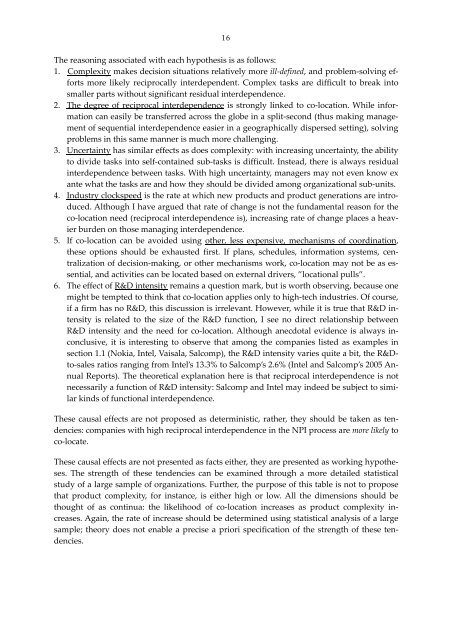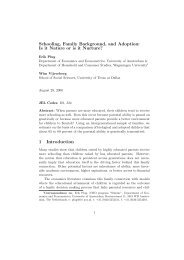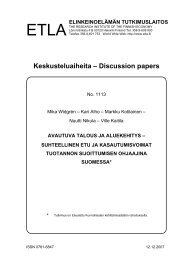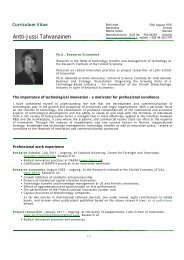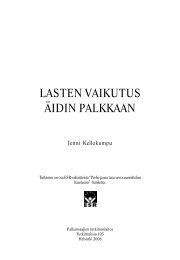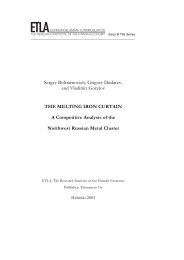Download PDF - Etla
Download PDF - Etla
Download PDF - Etla
Create successful ePaper yourself
Turn your PDF publications into a flip-book with our unique Google optimized e-Paper software.
16<br />
The reasoning associated with each hypothesis is as follows:<br />
1. Complexity makes decision situations relatively more ill‐defined, and problem‐solving efforts<br />
more likely reciprocally interdependent. Complex tasks are difficult to break into<br />
smaller parts without significant residual interdependence.<br />
2. The degree of reciprocal interdependence is strongly linked to co‐location. While information<br />
can easily be transferred across the globe in a split‐second (thus making management<br />
of sequential interdependence easier in a geographically dispersed setting), solving<br />
problems in this same manner is much more challenging.<br />
3. Uncertainty has similar effects as does complexity: with increasing uncertainty, the ability<br />
to divide tasks into self‐contained sub‐tasks is difficult. Instead, there is always residual<br />
interdependence between tasks. With high uncertainty, managers may not even know ex<br />
ante what the tasks are and how they should be divided among organizational sub‐units.<br />
4. Industry clockspeed is the rate at which new products and product generations are introduced.<br />
Although I have argued that rate of change is not the fundamental reason for the<br />
co‐location need (reciprocal interdependence is), increasing rate of change places a heavier<br />
burden on those managing interdependence.<br />
5. If co‐location can be avoided using other, less expensive, mechanisms of coordination,<br />
these options should be exhausted first. If plans, schedules, information systems, centralization<br />
of decision‐making, or other mechanisms work, co‐location may not be as essential,<br />
and activities can be located based on external drivers, ”locational pulls”.<br />
6. The effect of R&D intensity remains a question mark, but is worth observing, because one<br />
might be tempted to think that co‐location applies only to high‐tech industries. Of course,<br />
if a firm has no R&D, this discussion is irrelevant. However, while it is true that R&D intensity<br />
is related to the size of the R&D function, I see no direct relationship between<br />
R&D intensity and the need for co‐location. Although anecdotal evidence is always inconclusive,<br />
it is interesting to observe that among the companies listed as examples in<br />
section 1.1 (Nokia, Intel, Vaisala, Salcomp), the R&D intensity varies quite a bit, the R&Dto‐sales<br />
ratios ranging from Intel’s 13.3% to Salcomp’s 2.6% (Intel and Salcomp’s 2005 Annual<br />
Reports). The theoretical explanation here is that reciprocal interdependence is not<br />
necessarily a function of R&D intensity: Salcomp and Intel may indeed be subject to similar<br />
kinds of functional interdependence.<br />
These causal effects are not proposed as deterministic, rather, they should be taken as tendencies:<br />
companies with high reciprocal interdependence in the NPI process are more likely to<br />
co‐locate.<br />
These causal effects are not presented as facts either, they are presented as working hypotheses.<br />
The strength of these tendencies can be examined through a more detailed statistical<br />
study of a large sample of organizations. Further, the purpose of this table is not to propose<br />
that product complexity, for instance, is either high or low. All the dimensions should be<br />
thought of as continua: the likelihood of co‐location increases as product complexity increases.<br />
Again, the rate of increase should be determined using statistical analysis of a large<br />
sample; theory does not enable a precise a priori specification of the strength of these tendencies.


